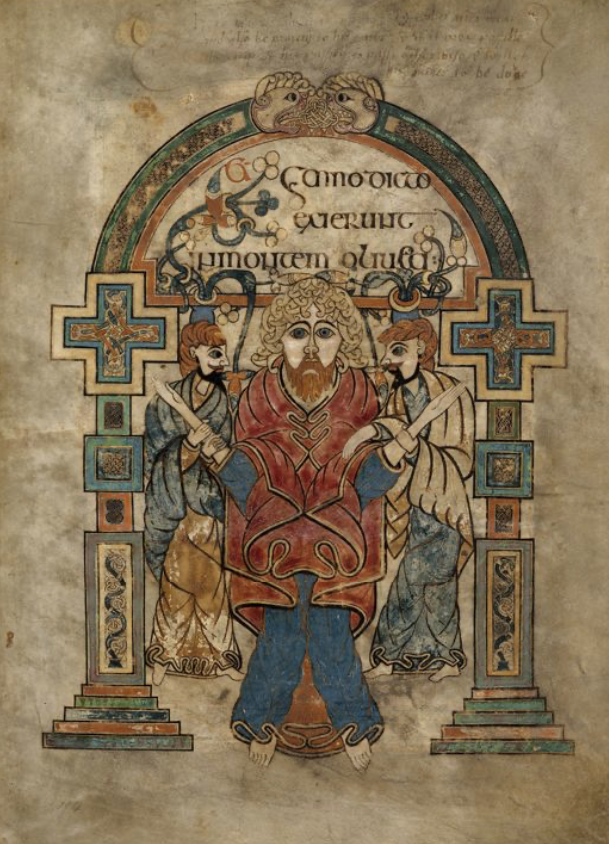 “folio 114r, Book of Kells”, Trinity College Dublin. (revised from October 2019)
“folio 114r, Book of Kells”, Trinity College Dublin. (revised from October 2019)
This page illustrates Matthew 26:30: “And when they had sung a hymn, they went out to the Mount of Olives.” The scene has been interpreted as “a drawing of Christ seized by two Jews”, first published by John Obadiah Westwood in 1843. More recently, it has been pointed out that that his interpretation neither fits the text being illustrated, nor the image. The two figures flanking Christ look like disciples, not soldiers. In fact, they resemble the central figure of Christ. Moreover, If this were the arrest, where are their weapons? Where is Judas, who betrayed him with a kiss? In fact, the crosses which are prominent on either side and chalices and vines in the base of the pillars’ detail, suggests that Christ’s sacrifice as a whole is in view. Moreover, with this verse the Passion begins, so that this illustration introduces a new section of the Gospel. The image has a liturgical feel. It should be remembered that Matthew 26:30 follows directly from the institution of the Eucharist (Mt 26:26-29). It has been noted that the three figures are dressed like priests. The steps at the bottom of the border which frames the three figures might be taken to suggest the entrance to the sanctuary of a Church. Christ stands with raised arms. This look like a liturgical gesture of prayer and is the most striking element in the illustration. But then, who are the two figures on either side of Christ? There are not stock figures because the illustrator shows subtle differences between them. Notice how differently each is related to the central figure of Christ. The folds on the helm of the tunic of the right hand figure are the same as those of Christ’s tunic. You should be able to see that this figure is slightly closer to Christ. This figure’s head is slightly bigger too. But the biggest clue to the identity of this figure on the right is the position of his elongated right hand. It touches Christ’s breast, which suggests that this is in fact the beloved disciple. He touches Christ’s outer garment suggesting the way that the beloved disciple leaned on Christ’s breast at the last supper. The strong resemblance between them suggests that they could be brothers. The monks who made the Book of Kells would have understood the beloved disciple to be the Apostle John, and so maybe they were showing the two brothers, James and John. However, there is another problem for us in so far as does not say that the brothers supported the arms of Christ as he prayed in Gethsemane. In fact, it says that they fell asleep. A few verses later on, Jesus rebukes them and Peter, saying to Peter, “So, could you not watch with me one hour?” ( Mt 26:40). In the Greek text accepted today as correct, and in the Latin Vulgate, the word “you” is plural, so that we take it that all three slept. However, in the Latin text used for the Book of Kells the word “you” is singular. This implies that the monks who made the Book of Kells believed that only Peter slept and that the brothers James and John stayed awake and supported Christ in his agony. But the gospel does not mention that these two disciples held Christ’s arms up. Now this is why the scene with Moses’ arms held up in prayer is significant. Could this be an allusion to the famous scene in our first reading, in which Aron and Hur hold up the arms of Moses, so that he can continue to pray despite his exhaustion? This scene with Moses has often been understood as foreshadowing the outstretched arms of Christ on the cross and the one single sacrifice of Christ made present in the Mass. It is interesting to note the fact that in various texts which come from the great dispute over the date of Easter, writers identify Peter with the “Roman” Church and John with the “Columban” Church. There is evidence that suggests that in the “Columban” Church these verses from Matthew were read on Holy Thursday. Look again at the two figures flanking Christ. Look at their feet. See how they move towards Christ. Look how their eyes are fixed on Christ who prays for the salvation of the world! It is this not Christ, the High Priest, who offers one single sacrifice for the forgiveness of sins? Unlike the disciples, who in today’s gospel are asked to persevere in prayer, Christ’s prayer is without end. From all eternity, he is praying for us!
Go to www.digitalcollections.tcd.ie to view the Book of Kells online.
The Catholic Chaplaincy serves the students and staff of the University of Edinburgh, Edinburgh Napier University and Queen Margaret University.
The Catholic Chaplaincy is also a parish of the Archdiocese of St Andrews and Edinburgh (the Parish of St Albert the Great) and all Catholic students and staff are automatically members of this parish.